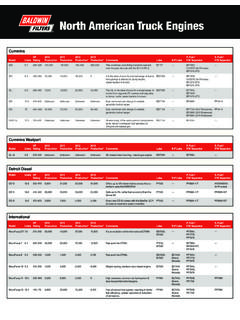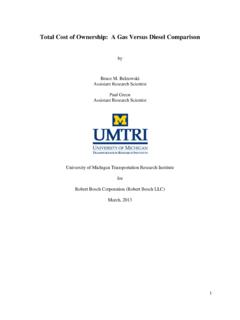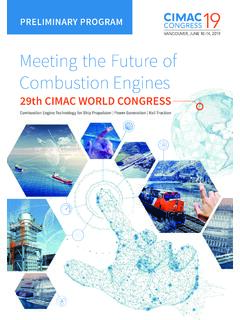Transcription of THE HISTORY, EVOLUTION, AND PROFILE OF ... - Home | …
1 THE history , evolution , AND PROFILE OFPERSONAL WATERCRAFTA Report by the Personal Watercraft Industry AssociationJanuary 2006 TABLE OF CONTENTSI. evolution of the Personal Today s PWC can accommodate three people, and feature state-of-the-art, environmentally-friendly engine technology. II. New Technology .. watercraft today are 75 percent quieter and up to 90 percent cleaner than pre-1998 Environmental every environmental assessment conducted by the National ParkService since 2002 the conclusion is the same personal water-craft present no significant environmental Safety .. watercraft manufacturers support mandatory boatingsafety education for all PWC operators. V. Conclusion .. publication has been created to describe the history andtechnological evolution of personal watercraft, or PWC, whichare small boats more commonly known by the manufacturers brand names: JET SKI , WaveRunner , Sea-Doo , or AquaTrax.
2 This document explains how, in an effort to meet consumerdemands in the past decade, personal watercraft have evolvedfrom the single-person stand-up vessels of years gone by to inno-vative, multi-passenger family boats offering state-of-the-art fea-tures and functions. Additionally, and contrary to false rhetoric,this publication describes in detail the enhancements made toPWC engine and design technology since the 1998 model yearthat have catapulted today s PWC into one of the most envi-ronmentally-friendly motorized recreational vessels on 2000, a handful of national parks were unfortunately forcedto prohibit the use of PWC because of alleged harmful envi-ronmental impact, despite evidence to the contrary.
3 Today, 15of these parks have completed environmental assessment stud-ies and every one has concluded PWC present no significantunique environmental impact compared to other boats. The pre-ferred rule is consistent in all 15 parks PWC should no longerbe banned. More information can be found at or by callingPWIA at evolution OF THE PERSONAL WATERCRAFT(PWC)The personal watercraft (PWC) conceptoriginated in the 1960s, combining theelements of self-power, small size and amaneuverable, active vessel. Bombardier Recreational Products,known for its Ski-Doo snowmobiles,introduced a personal watercraft slightlyresembling what we know today as aPWC in the late 1960s, with limited suc-cess.
4 This craft is credited for being thefirst sit-down style PWC. In the early1970s, Kawasaki Motors Corp. the JET SKI watercraft, thefirst commercially successful are currently four major companiescurrently active in the personal watercraftmarket. In the mid-1980s, Kawasaki's JETSKI watercraft was joined by YamahaMotor Corp. Their product line ofthe WaveRunner model created a mar-ket shift from the stand-up to the sit-downstyle PWC with one- and two-personcapacity. Shortly thereafter, BombardierRecreational Products re-joined the mar-ket with their Sea-Doo line. Most recent-ly, in 2002, American Honda began sell-ing its version of a PWC, the AquaTrax . Along the way, two-person sit-down craftquickly took over from the single personstand-up model.
5 Today, three-person fam-ily models are the most popular. Multi-person family craft currently make upapproximately 99 percent of personalwatercraft popularity grew very rapidly in theearly 1990s and what was once a smallportion of the recreational boating mar-ket became the fastest growing sport inthis category. Simultaneously, the PWCindustry was for a time the fastest grow-ing segment of the marine business. Personal Watercraft sales of PWC peaked in 1995 withapproximately 200,000 units sold. Salesof personal watercraft declined from1996 through 2001, but began to leveloff in 2002 with sales of 79,300 industry saw sales in 2004 of morethan 79,500 to the National MarineManufacturers Association, there wereapproximately million PWC ownedin 2004.
6 The average retail price of aPWC in 2004 was $9,226. Since themid-1990s, sit-down style, multi-passen-ger watercraft have made up around 99percent of all PWC sales, with three-person family models being the fastestgrowing segment. According to the 2000 National Survey on Recreation and theEnvironment (NSRE), approximately 20million Americans ride personal water-craft each owners spend millions on the sportannually. In addition to purchasing thevessel, they spend money on boatingregistration fees, launch fees, trailers,fuel, insurance, clothing, accessories,food, travel, and in the PWCI ndustryNearly 6,000 people are employed inthe United States by PWC manufacturersin at least 11 states.
7 Other financialimpacts of the sport include employmentin more than 2,000 retail businessesservicing and selling PWC, aftermarketand related small businesses manufac-turing components and accessories, cor-porate tax revenues from PWC-relatedbusinesses, local and state sales taxes,and gas tax Personal WatercraftConsumerToday's personal watercraft are afford-able family boats with clean, quiet, fuel-efficient engines and no exposed pro-pellers. Manufacturers have respondedto customers' desire for environmentally-friendly recreation, and have createdcleaner, quieter and more versatile per-sonal , PWC manufacturers havefocused their new model designs ontoday's consumer base families thus, continuing to perfect and producemore of the three-person models.
8 Thesemodels now account for more than 75percent of today s PWC market. Recentdata shows the average purchaser of anew PWC in the last five years is 41years old. About 85 percent are male,71 percent are married, 69 percenthave owned a powerboat prior to theirmost recent PWC purchase, and 66 per-cent have taken or completed college-level course work. Forty-two percent ofthose PWC owners have owned water-front property, and over 60 percenthave access to a home on the water,whether it is their primary home or thehome of a close friend or 's consumer is likely more diversewith the broader selection of models cur-rently available, which appeal to manydifferent people.
9 2004 PWC SalesPWC Sold:79,500 Total Retail Value:$733,454,700 Average Unit Cost:$9,226 PWC Owned:1,480,000 Source: NMMA Recreational BoatingStatistical Abstract, 20043 Who is the Average PWC Customer? 41 years of age 71% married 69% previous boat owners 66% college educatedSource: Survey by Bowe Marketing ResearchConsultantsIn 2001, Leisure Trends Group, a nationalconsumer research firm, surveyed con-sumer attitudes towards personal water-craft. Ninety-three percent of the respon-dents had positive attitudes towards thesafety of personal watercraft, particularly ifthe vessels were operated have also found that the mostcommon ways PWC are used (over 80percent) involve rides with family andfriends, short cruises, towing skiers,exploring, and entertaining friends.
10 II. NEW TECHNOLOGYP ersonal watercraft manufacturers areconstantly investing in research anddevelopment, leading to new technologythat improves their product lines. Since1998, PWC have evolved substantially tomeet consumer demands. Today s PWCare larger, seat up to three people, offerstorage space, and are capable of tow-ing a water skier. They are alsoequipped with new, environmentally-friendly engine personal watercraft were invented,these vessels have been equipped withthe same two-stroke engine technologythat powers marine outboard motors. Itwas only in the past decade that marineengine designs changed , many PWC are fuel-injected andthe vast majority of units sold featurestate-of-the-art four-stroke engines.





